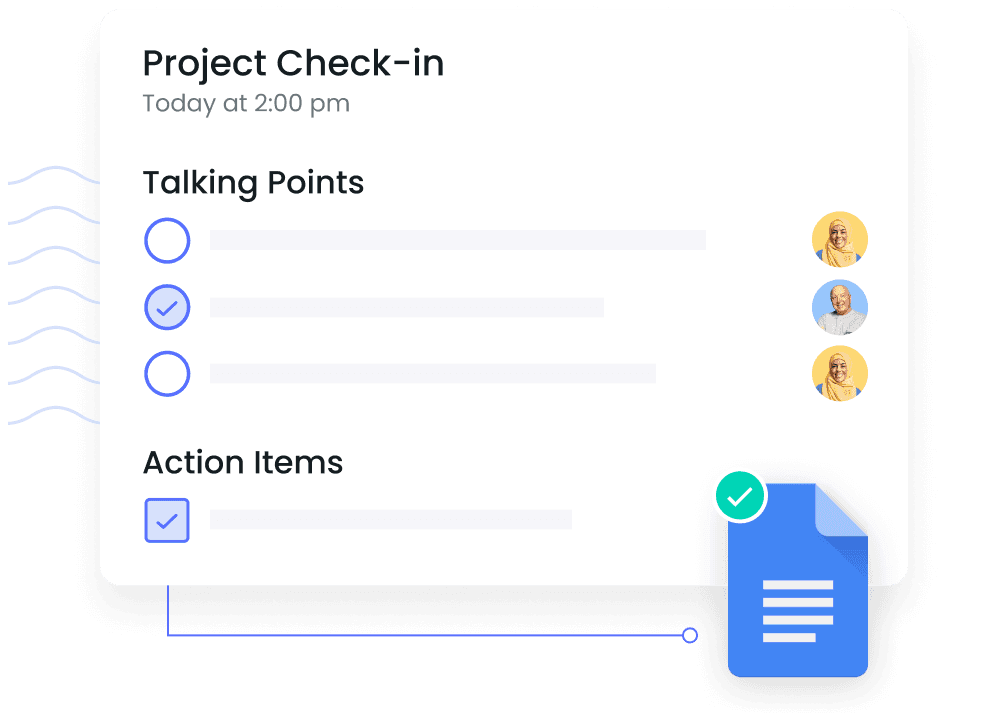•
9
MIN READ
In order to run an effective meeting, we all know that it’s essential that you start on time and stay on track. That said, if you’re not prepared for the meeting, it’s going to go down hill pretty quickly.
Any successful meeting requires good organization, planning and collaboration with the rest of your team members. An effective meeting has to be necessary, so it’s really important that you think about the purpose of the meeting, what you’re trying to achieve and who needs to be in attendance.
To make sure that you feel confident to run an effective meeting, Fellow is here to outline 14 tips and effective meeting strategies so that you feel prepared for the meeting every time.
14 effective meeting strategies
1. Determine if you actually need a meeting
Before you begin thinking about the content of your meeting, you need to ask yourself, do we really need to have this meeting? Time is precious for you and for all of your team members so think about if this is going to be an effective use of time. Technology has advanced in our favour, meaning that sometimes a discussion can still be effective via email, an instant chat, or by stopping by a team member's desk for a quick conversation. If multiple people need to be involved in the discussion and the topic warrants some more time and more careful consideration, then you can start organizing who needs to attend the meeting so that you can coordinate calendar invites and encourage effective meetings.
2. Plan the meeting agenda carefully
It’s important that you plan and structure the meeting agenda thoughtfully. Think about which topics need to be covered to achieve your meeting goal and how much time each agenda item warrants and can have with the time you’ve booked to have your meeting.
Each item on the meeting agenda should contribute to the main topic or objective of the meeting. If it isn’t related, make sure to put those comments in the parking lot, so that you remember to bring them up another time. When creating a meeting agenda, you don't need to start from scratch.
3. Curate the attendee list
There’s nothing more frustrating than sitting through a meeting that isn’t relevant to you or the work that you do. When creating your invite list for your meeting, only invite people who are directly involved in the project or discussion. If there are people in the meeting who aren’t able to make decisions or contribute to the conversation, their attendance is likely not needed.
Make sure to only invite key players so that you respect the time and energy of others. If you notice that someone essential to the meeting isn’t available, consider asking them if they would feel confident sending one of their team members to go in their place. If that person is truly needed, hold off on the meeting so that you can ensure it’ll be productive when the time comes.
4. Define a clear objective
Everyone’s time is precious and there’s nothing more frustrating than being 20 minutes into a meeting without any clue of why you’ve been asked to be there! Be sure to create a main goal or purpose of the meeting so that you can work towards achieving it. When you highlight a specific reason that you’re coming together for a meeting, it’s going to maximize your chances of keeping your meeting on track because you are continuously working towards that goal. If you notice the conversation trailing off a little bit, all you have to do is ask if it’s related to the main purpose of the meeting. If it isn’t related, bring the conversation back to its main conversation.
5 Attach supporting documents to help others prepare
Attach useful and informational supporting documents to your meeting invite. This may help you paint the picture a little more clearly for your team. You should also set the expectation with your team that you would like them to read and become familiar with the supporting materials before the meeting takes place. Think about if any kinds of documentation or information helped you put together and structure the meeting in the first place. If they helped prepare you for the meeting, consider attaching them for the benefit of your teammates as well. These supporting documents don’t need to be formal but can be any articles or blog posts that have provided you with any kind of valuable insight that you feel may add value to your team members and to the upcoming meeting.

6. Assign specific times to each section of the meeting
Assign a time limit for each item on your meeting agenda when you’re deciding which topics to cover. Allocate the most time to topics that are the most important, the most complex or require a longer discussion such as any kind of brainstorming, a plan for mitigation, or more extensive clarification. Be conscious of time and always assume each agenda item is going to take a little bit longer than it should so that you allow some time at the end for any further questions or discussion. Assign specific times to each item so that you can keep focus and remain productive.
If there’s anything that requires further discussion, plan to have that conversation either informally or in another meeting so that you keep on track with the timing of that particular agenda item.
7. Delegate the roles of notetaker and timekeeper
Before the meeting, make sure that each person’s role in the meeting is clearly defined and understood. If expectations are not defined before the meetings occur, it doesn’t allow attendees to come prepared and therefore, the meeting isn’t going to be productive. This means that you will want to generally assign a facilitator, a note-taker, a timekeeper, and so on.
Each person attending the meeting should serve a specific purpose and should be a part of the decision-making process. If that’s not the case for certain individuals, their attendance probably isn’t necessary. All team members should understand expectations and what is required of them in each meeting so that they can come feeling prepared every time.
8. Bring all voices into the conversation
The reason the meeting has been called in the first place is because you can’t make this particular decision alone and because collaborative decisions are much more effective. For this reason, you really need to encourage the full participation of each person in the meeting. Multiple perspectives are going to be beneficial in order to identify opportunities for improvements, goal-setting, strategizing, and executing plans for success. Take this time to be a good listener, to make participants feel comfortable to voice their perspectives and opinions, and to consider various different approaches to the situation.
9. Record meeting notes and decisions
Make sure that someone is writing meeting minutes, whether you assign it or make it your own responsibility. It’s a good idea for whoever is writing the meeting minutes to write them down as the meeting unfolds. When you write your meeting minutes in real-time, you’re going to capture the most realistic representation of the meeting.
Sometimes, it’s difficult to recall everything that was discussed, the decisions that were made, and the action items that need to be completed for the next meeting. Along with action items, be sure that the key decisions are included in the meeting minutes. Because these notes serve as a permanent record of the discussion and decisions that were made, it’s important that as many details as possible are captured, especially for people who weren’t able to attend the meeting.
10. If you're the leader, speak last
Leadership expert Simon Sinek suggests that the leader should speak last at the meeting. He explains this strategy when he says,
“The skill to hold your opinions to yourself until everyone has spoken does two things: One, it gives everybody else the feeling that they have been heard. It gives everyone else the ability to feel that they have contributed,” he explained in a speech. “And two, you get the benefit of hearing what everybody else has to think before you render your opinion.”
Giving the opportunity to your team members to speak up about their opinions and views on matters is going to help build their confidence, leadership skills and foster a stronger group synergy.
11. End with clear action items and DRIs
End your meeting by making sure the action items are clear and by assigning each item to directly responsible individuals (DRIs). Record any decisions or action items as soon as they happen so that you can transcribe them with accuracy. This way, you can hold each other accountable for your responsibilities and support one another in getting tasks done that bring you closer to achieving your organizational goals. You can also choose to open the next meeting by going over the action items from the previous meeting to understand the progress and status of the project.
12. Send a meeting recap
Send a meeting recap to your team members whether it be meeting notes, a meeting summary, or any other kind of meeting documentation. Sending a meeting recap is not only useful for people who weren’t able to attend the meeting, but for the attendees who were there because it reconfirms and reinforces the information, discussion, and key decisions. When you’re deciding who to send your meeting recap to, you can include stakeholders or team members who didn't attend the meeting but want to be informed and keep on top of the progress of your project. This document serves as a historical record of the meeting that can be referenced in the future to keep track of your organizational goals.
13. Ask for feedback (How effective was this meeting?)
Consider asking the attendees for feedback and asking them how effective the meeting was. If your team is a little shy or if you think it would be more effective, you can hand out an old-fashioned paper feedback form or otherwise, have a live survey at the end of the meeting where participants can give their two cents on the productivity, effectiveness, enjoyableness and overall satisfaction with the meeting. This feedback will be important to reflect on for the next time that you organize a meeting of similar nature. Moreover, you can tailor the questions that you’re asking your team to address specific topics that you want to unfold a little more.

Learn more about Fellow's meeting feedback feature
14. Evaluate and clean up your schedule every quarter
A final effective meeting strategy is to take a look at your calendar and clean up your schedule once per quarter. This is a good opportunity to think about if you have any meeting organized that can be addressed in a different way, other than meeting formally. By cleaning up your schedule, you’re also familiarizing yourself with the upcoming meetings and which topics will be discussed in the coming weeks. Even if you’re not spending time reading each meeting invite in-depth, this is going to help you be better prepared for your upcoming discussions. Consider also time blocking your calendar if you have major projects with deadlines fast approaching so that you can focus knowing your work won’t be interrupted.
Parting advice
Remember that meetings are costly to an organization. It's important to use you and your teams time efficiently! With these tips and strategies, we hope you can look at your calendar and meeting agendas in a new perspective that will make each meeting run effectively. Until next time!
Never take meeting notes again. Fellow auto-joins your video calls to get you the most accurate transcripts, summaries, and action items from your meetings.







